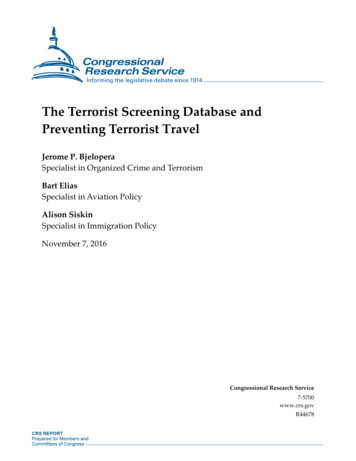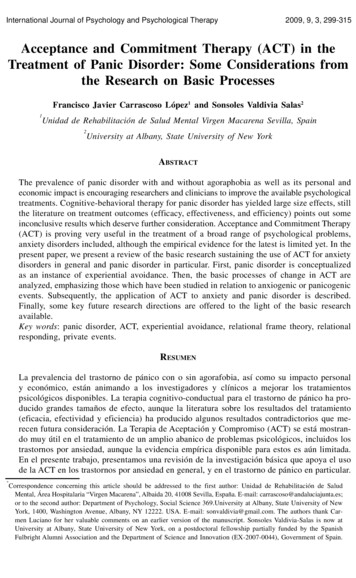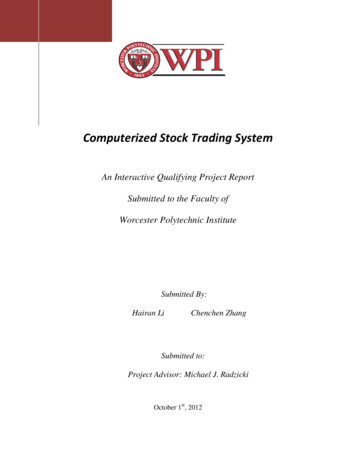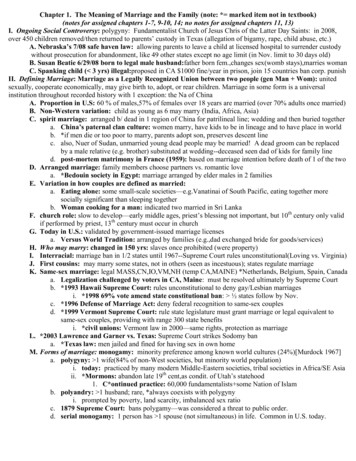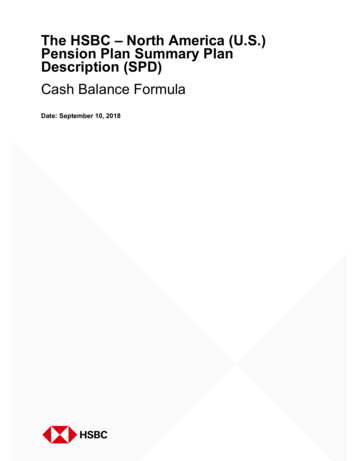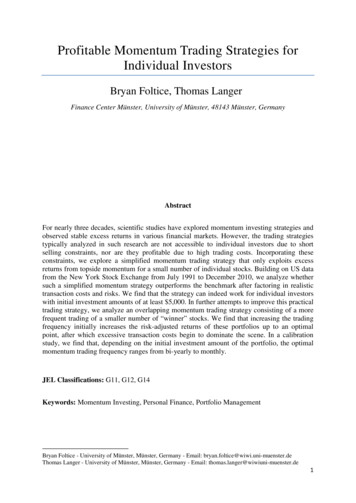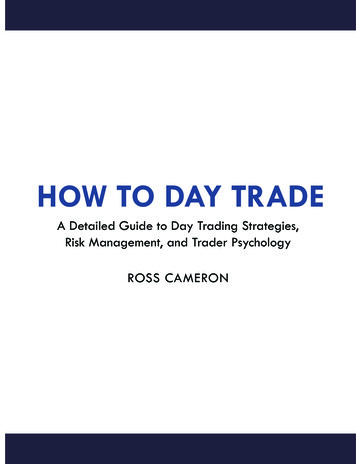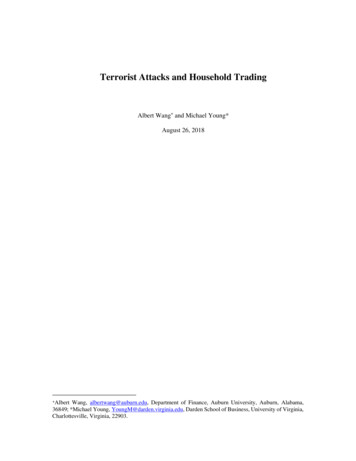
Transcription
Terrorist Attacks and Household TradingAlbert Wang and Michael Young*August 26, 2018 AlbertWang, albertwang@auburn.edu, Department of Finance, Auburn University, Auburn, Alabama,36849; *Michael Young, YoungM@darden.virginia.edu, Darden School of Business, University of Virginia,Charlottesville, Virginia, 22903.
Terrorist Attacks and Household TradingUsing two sources of household data, we show that an increase in terrorist attacks leads individualinvestors to reduce stock market participation and overall trading activities. The effects of attacksare evident both in households located in the state of the attack, as well as those living in largemetropolitan cities. We find support for a flight home effect through the increase in trading of localstocks following attacks. Adding to the recent literature on gender and market stability, we findthat the main results are concentrated in male traders and households with married couple. Inaddition to a drop in equity market participation, households respond by increase the value of theirsavings.Key Words: Terrorism, Stock Market Participation, Household Finance, Local BiasJEL Classification: G11, G14, H56
1. IntroductionUnderstanding the degree of trading activity by individuals is itself one of the greatchallenges for finance academics (Grinblatt and Keloharju, 2001). Many households make tradingdecisions that are hard to reconcile with standard finance theory. Indeed, existing literature largelyfocuses on household investors’ suboptimal behaviors in the equity market: limited marketparticipation (Mankiw and Zeldes, 1991; Vissing-Jorgensen, 2002) and excessive trading (Odean1999; Balduzzi and Sunden, 2003).1 According to Campbell (2006), the discrepancies betweenobserved and optimal behaviors among household investors can be partially explained bynonstandard behavioral models that incorporate loss aversion and sentimental bias. Building on thisidea from Campbell (2006), the goal of this paper is to shed light on households’ trading activitiesand equity market participation by examining the effect of terrorism on household investmentdecisions.We start by examining households’ trading activities in the month after terrorist attacks.We then further examine the characteristics of stock purchases and possible mechanisms that couldbe causing any changes in behavior. In the lead up to the 2016 presidential election, voters listedterrorism as the campaign issue that was most important to them, behind only the economy (PewResearch Center, July 2016). In addition to voting decisions, terrorism and terrorist attacks affectindividual consumption, short-term stock prices, mutual fund flows and corporate decisionmaking.2 With these findings on the wide-ranging effects of terrorism, it is possible that furtherexamination would help add to understanding why households deviate from optimal tradingdecisions that could maximize their welfare.1An overview of the individual trading literature can be found in Barberis and Thaler (2003).Arin et al. (2001) examine the effects of terrorism on six different global financial markets. Chesney et al.(2011) examine the effects of terrorist attacks on global financial markets and certain industries. Eckstein etal. (2004) look at the effect on the Israeli economy, as do Llussá et al. (2011). Wang and Young (2018) studymutual fund flows and Antoniou et al. (2016a) look at the effect of attacks and school shootings on corporateinvestment and cash holdings.21
To determine the effects of terrorism on household trading we use two sources of individualinvestor data, combined with a comprehensive list of terrorist attacks from the past 40 years. Whileprevious studies on terrorism use only a handful of large events, we use a larger sample of all salientattacks. This approach is similar to Wang and Young (2018), and consistent with Drakos (2010)finding that events causing “minor” psychosocial effects can still alter behavior. A comprehensivelist of terrorist attacks is taken from Enders et al. (2011), and paired down to ensure that all attacksare likely to be salient to household investors.3From 1991 to 1996, we find that the value of households’ net purchases, as a percentageof total equity holdings, drops significantly in the month following an increase in the level ofterrorism. A one standard deviation increase in the number of attacks, roughly equivalent of goingfrom the mean of two attacks in a month to four attacks, leads active traders to reduce their netpurchases by 20%.4 In terms of dollars, this equates to a drop of 1,472, relative to an averagemonthly net purchase of 7,235. Breaking net trades into buys and sells, we find that a drop in thevalue of both buying and selling accompanies the net drop in trade value.If terrorism is causing households to reduce their net purchases and limit trading activity,it is possible that it will also limit their willingness to participate in the equity market all together.Aggregating the number of salient attacks each year, we find that households significantly reducetheir level of market participation in years with higher terrorist activity. Following a one standarddeviation increase in the level of terrorism, akin to going from 9 attacks in a year to 16 attacks,there is a 6% drop in the likelihood that households own equity. A further study of householdsavings accounts reveals a significant increase in the value of savings, relative to household wealth.Overall, these initial results show that terrorist attacks lead households to limit two important stockmarket related behaviors: trading activity and equity ownership.3An attack is included and considered salient if it is covered in the news or involved injuries or casualties.Households in the individual trading data are classified as active traders, affluent household, and generalaccounts. We use active traders because general and affluent traders trade at a much lower frequency andresults may suffer from an inattention bias.42
A significant difference between terrorism, and related studies on corporate scandals andnatural disasters by Giannetti and Wang (2016) and Barath and Cho (2014), is that terrorism canaffect individuals far outside just the local area of an attack. Galea et al. (2002) and Schlenger etal. (2002) show that individuals living in large cities as well as those living close to the attacks aremost likely to be affected. Using household location data from a subsample of the brokerage data,we find that the effects of terrorism are evident both at the local level, and in households located inlarge metropolitan cities outside the immediate area of the attacks.In addition to the location of the investor, gender and relationship status are significantpredictors of an individual’s response to terrorism. Biais et al. (2005) find that men are much moresusceptible to the effects of psychological variables, while the same effects are non-existent inwomen. In addition to gender, Roussanov and Savor (2014) study the risk taking of married CEOsand show that relationship status, with respect to married or single head of households’, may playa significant factor in behavior as well. Consistent with these studies, we find that households witha male designated as the head and households with married couples significantly change theirbehavior following attacks. On the other hand, households with a single or female head do not altertheir behavior in response to attacks. Cueva et al. (2015) and Kandasamy et al. (2014) find thatfemale traders are less susceptible to the effects of increased cortisol,5 and thus provide stability tofinancial markets. The result of our gender tests provide some of the first large-scale real worldsupport for these resent experimental studies.To this point, our tests have focused on identifying the change in behavior and examiningthe cross section of households. We next examine the characteristics of stocks purchased andpossible mechanisms that lead to such change. We focus on buys because the possible universe ofstocks is unconstrained, whereas the characteristics of stocks sold is dependent on the stocksalready in the portfolio.5Increased levels of cortisol are linked with depression, depressive moods and increased stress as well(Burek et al., 2005)3
We find that following attacks, investors respond by purchasing fewer risky stocks, ascharacterized by high idiosyncratic volatility and skewness. This is consistent with findings in bothAntoniou et al. (2016a) and Wang and Young (2018) that through fear and depression, investorsbecome more risk averse after attacks. Next, we follow the literature on home bias in investing, andthe effect of patriotism on holdings,6 and examine the time variation in home bias as it relates tolocal attacks. Interestingly, we find that following an attack in an investor’s home state, householdsdevote a larger percentage of their purchases to stocks headquartered in that state. With this result,we add to the home bias literature by documenting a flight home effect whereby householdsrebalance their portfolios in favor of local stocks after local attacks.A previously unexamined factor in related studies on terrorism is the effect that attackshave on investors’ attention to financial markets. With respect to terrorism, multiple studies haveshown a strong correlation between the effects of terrorism and news coverage, and for thoseindividuals that consume more news coverage of the event.7 If during periods of higher levels ofterrorism individuals focus their attention on news coverage of the events, rather than coverage ofthe stock market, it is possible that their reduced attention to market/firm related news is a factorin the reduction of trading activity that we observe (Peress and Schmidt, 2016). Following Barberand Odean (2008) to identify high attention stocks, we find that individuals are less likely topurchase high attention stocks following an increase in attacks.Lastly, we examine the extent to which individuals recognize industry risk followingattacks and how that affects their behavior. Using stocks that Chesney et al. (2011) identify as mostaffected by terrorist attacks, we find that investors are generally rational in their response to attacks.Chesney et al. find that the defense industry is least affected by attacks, while the insurance industryis most commonly negative affected. In accordance with these common outcomes, we find that6Building on Coval and Moskowitz (1999), Grinblatt and Keloharju (2001) and Seasholes and Zhu (2010)find that individual investors exhibit home bias in their portfolios. In a related paper Morse and Shrive (2011)find that countries that are more patriotic exhibit more home bias.7See Sloane (2000); Schlenger et al. (2002); Melnick and Eldor (2010).4
investors increase their purchases of stocks in the defense industry and decrease their investmentof stocks in the insurance industry.Finally, we examine the extent to which the effects of terrorist attacks on trading behaviorare transient. Using the brokerage data, we find that the effect of terrorist attacks on net purchasespersists for a total of 4 months, the month directly after attacks and a following three months.Additionally, we do not find any significance on the attack variable for the month before the attackstook place. To ensure that the continuous attack variable is not driving the results, we create atercile rank variable as well as a high attack dummy variable and find consistent results in both thePSID and trading samples.In response to low proportion of households holding stocks, previous studies identify fixedcosts that limit equity market participation.8 One type of fixed costs can be measured by time andmoney that are involved with investing in stock market. For example, Vissing-Jorgensen (2003)find that the complication of tax returns through equity ownership affects an individual’swillingness to participate in the market. Alternatively, fixed costs may be related to psychologicalfactors that make equity ownership uncomfortable for some households (Campbell, 2006). BothGuiso, Sapienza, and Zingales (2005) and Giannetti and Wang (2016) find that lack of trust canreduce the likelihood that households invests in the equity market. In addition to trust, Barath andCho (2016) show that exposure to natural disasters lead households to limit market participation.We add to the literature by identifying terrorism as another important example of psychologicalrelated fixed costs that limit individuals to participate in the equity market.In addition to equity market participation, individual brokerage data allows us to examinevariations in trading activity. This is important, as Shum and Faig (2006) find that predictinghouseholds the value of stock owned is much more difficult than predicting which houses will ownstock. Numerous studies have examined the relationship between personal characteristics andAccording to the Federal Reserve Board’s Survey of Consumer Finances, only 50% of American familieshave any exposure (direct or indirect) to the stock market.85
trading activity,9 but much less has been done on the way external factors affect trading at thehousehold level. While weather, seasonal change and calendar effects have been used previously,a terrorist attack is unexpected by households and elicits much different emotions; including fearand patriotism.10 Exploring terrorism effect on trading activity provides new insight into the waythe nonstandard behavioral models discussed in Campbell (2006) can explain variation inindividual trading behavior.Finally, most papers examining the effects of terrorist attacks on mood and behavior havefocused mainly on aggregate price effects or investors as a whole. For example, Wang and Young(2018) examine terrorism’s effect on aggregate risk preference through mutual fund flows, whileKamstra et al. (2015) examine the effect of Seasonal Affective Disorder (SAD) on fund flows.Antoniou et al. (2016a) and Antoniou et al. (2016b) study the shift in corporate policies and changein equity analyst forecasts following attacks, respectively. This is among the first set of studies thatdirectly examines the behavior of individual households related to terrorism. As demographic datais unavailable for mutual fund flows, we are able to study the effect that individual characteristicshave on the response to terrorism. This is important as most of the existing literature considerhousehold investors as less sophisticated, uninformed and noise traders (Barber and Odean (2008);Grinblatt and Keloharju (2009)). Using terrorist attacks, we add to existing studies on householdinvestors, and show that their investment decisions are significantly affected by the emotional fallout of certain non-economic shocks.The reminder of this paper will proceed as follows. Section 2 reviews the literature andarticulates the hypotheses. Section 3 describes the data. Section 4 examines the effect of terrorismusing individual brokerage and household survey data. Section 5 presents the results on stockselection after attacks. Section 6 provides robustness test, and Section 7 concludes the paper.9Gribblatt, Keloharju and Linnainmaa (2012), Grinblatt and Keloharju (2009), Odean (1999), Barber andOdean (2001), Barnea, Cronqvist and Siegel (2010).10 See Kaustia and Rantapuska (2016), Loughran and Schultz (2004).6
2. Linking Terrorism, Market Participation and Trading BehaviorWhen planning and committing attacks, terrorists have two main goals: cause destruction,and create fear in the civilian population. Whether an individual lives in close proximity to an attackor observes the aftermath from afar, there is a wealth of evidence from medical studies thatterrorism can increase the negative sentiment and depressive moods of individuals. Both in the U.S.and overseas, previous studies show that the level of depressive moods and even PTSD increasesin the civilian population directly affected by attacks. Following the attacks of September 11 th,Galea et al. (2002) and Schlenger et al. (2002) find that the level of depression and the number ofindividuals exhibiting the symptoms of PTSD increases significantly. Over longer stretches,Hobfoll, Canetti-Nisim and Johnson (2006) find citizens of Israel who are exposed higher levels ofterrorism are more likely to exhibit signs of depression and PTSD.If terrorism and terrorist attacks are altering the sentiment and moods of the affectedindividuals, then there is clear evidence that it is likely to affect trading behavior. Examining tradingbehavior of Finnish individuals, Grinblatt and Keloharju (2009) find that individual level ofsensation seeking strongly correlates with trading behavior.11 Various other studies have examinedwhat causes individuals to make trades. Odean (1999) shows overconfidence leads investors totrade too much, while Barber and Odean (2001) show that this effect is larger in males. Linkingconfidence and depression, Stone et al. (2001) find that depressed individuals exhibit lessconfidence in decision making relative to their nondepressed counterparts.Thus far, the psychological studies referenced focus on local households; however, asignificant factor in terrorism is the attempt to intimidate a large group of individuals that outsidethe area of the attack. For these individuals not directly targeted by the attack, news coverage ofthe attack can trigger a shift in behavior. In both the psychology literature and traditional financeliterature, findings show that negative images lead individuals to alter behavior. Kuhnen and11Sensation seeking is akin to risk taking and is negatively affected by depressive moods (Carton et al.,1992).7
Knutson (2008) find that individuals exposed to negative images are more likely to choose a risklessasset when given the choice between a risky asset and a guaranteed payoff. In a similar study,Guiso, Sapienza and Zingales (2017) find that students shown scenes from a horror movie arewilling to pay more to avoid a risky lottery than students not shown the movie scene are. Usingthese studies as a baseline, it is possible that the effect of terrorist attacks will be felt in individualsthat live outside the immediate area of the attack. Along with results from the lab, empiricalevidence shows that an individual’s consumption of news through television is directly related todepressive moods. Schlenger et al. (2002) show that in the aftermath of 9/11, rates of PTSD in largecities such as Boston, Chicago, Houston etc. were not significantly different than rates inWashington D.C and New York. It is easy to understand that those individuals living closest toattacks would be affected by them, but these studies show it is clear that a much larger populationof investors are susceptible the effects of terrorist attacks as well.Just as mood affects trading behavior, it can have a similar effect on stock marketparticipation. If households are experiencing a change in mood, or updating their views of futurereturns or corporate cash flows, there is ample evidence that this will carry over to their marketparticipation. Previous studies on market participation have examined similar questions but focusedon time invariant personal characteristics. Puri and Robinson (2005) and Dominitz and Manski(2005) examine the effect that the level of personal optimism has on expectation of returns andinvesting activity and find that more optimistic individuals invest more in the stock market. In thiscase a change in mood and return expectations may be linked, in that the mood of the individualcould alter their view on the market. In either case, it is likely that terrorist attacks will lead to achange in behavior.With respect to market returns, Brounen and Derwall (2010) and Arin et al. (2008) bothfind a significant but short term drop in domestic stock markets following an attack in that country.Even if there is no drop in price for local firms, households may update their expectations of futurereturns. Antoniou et al. (2016b) find results consistent with the idea that individuals may become8
more pessimistic about future returns. Examining equity analysts they find that analysts locatedclose to terrorist attacks make more pessimistic forecasts. If sophisticated equity analysts are morebearish about firm earnings in the future, then it is likely that this effect could be found inhouseholds as well.Finally, households may be responding to larger macro-economic effects. Enders, Sandlerand Parise (1992) find tourists recognize the risk of terrorist attacks, and will vacation in countrieswith less terrorism, leading to a significant drop in tourism revenue. For the other macroeconomiceffects of terrorism Enders and Sandler (1996) provide a broad overview of other negative effectsattacks can have. They note that attacks can lead to lower foreign direct investment, and leadgovernments to shift assets and resources to defending the country from future attacks. While theseeffects may be less of a factor in the decision making of individual investors, they help to show thebroad impact terrorism has on an economy.Using results from previous studies as a guide, we hypothesize that an increase in terrorismwill alter household risk preferences and lead them to be less willing to participate in the stockmarket. This effect should be present in both those living close to the attack and those living fartheraway in large metropolitan areas. Finally, using brokerage data we hypothesis that attacks will leadto a short-term drop in the net value of household purchases.3. Data and MethodologyIn this section we describe the data sources that are used throughout the paper. We startwith the terrorism data and then describe the PSID data and the brokerage trading data.3.1. Terrorism DataTo measure the level of terrorism in the United States, we use a comprehensive list ofdomestic, and transnational terrorist attacks from Enders, Sandler and Gaibulloev (2011) who usethe University of Maryland’s Global Terrorism Database (GTD) and the International Terrorism:Attributes of Terrorist Events (ITERATE) database, to create their final database of attacks. We9
start with the Enders et al. data set and use the same method as Wang and Young (2018) to definemy final set of attacks. The Enders et al. data goes back to 1970, but we are limited by the dates ofthe individual trading and PSID data. To filter out attacks that may not be large enough thatinvestors to notice, we drop any attack that does not involve human casualties, death or is notmentioned in a national or local newspaper. This leaves a total of 457 attacks for the sample usingthe PSID survey data and 155 attacks in the individual trading sample.We use this set of terrorist attacks because it gives a more complete representation of thenature of terrorism. By including all salient attacks, we are able to capture the effects of all typesof terrorist attacks. Studying consumption and investment data from Israel, Llussá and Tavares(2008) show that the number of attacks has a larger effect than do the number of casualties becauseof the attacks. Similarly, Wang and Young (2018) provide evidence that the number of attackscorrelates with aggregate risk preference and mutual fund flows. Additionally, as we are attemptingto measure the effects of a widespread increase in terrorist activity, we beleive the number of attacksnationally is a more appropriate measure than single large attacks.Figure 1 reports the summary statistics for the control variables for both sets of householddata and the terrorist attacks. The brokerage data is aggregated at the monthly level from 1991 to1996, with the average number of attacks being 2.21 with a standard deviation of 2.37. For thePSID data, the average number of attacks in a year from 1984 to 2012 is 9.48 with a standarddeviation of 7.01.3.2. Brokerage Data and VariablesTo study household trading behavior, we use individual trading data from a large discountbrokerage. The data covers 1991 – 1996 and is geographically distributed across states similarly toU.S. census data (Korniotis and Kumar (2013)). It has been previously used in a series of papersthat examines household trading behavior and performance (Barber and Odean (1999), Barber andOdean (2000), Barber and Odean (2001)). The individual trading data includes individual account’sdaily trades and monthly holdings. For an additional sub-sample of the brokerage data,10
demographic information is available for the households. This includes location, gender,relationship status etc. The breadth of the individual trading data allows for a more robust analysisof trading behavior. For each trade made by a household, the date of the trade, the price paid forthe stock and the total shares bought are available.To create our main variables of interest we aggregate trades each month to conduct themain tests of net trade value, values of buys, and values of sales. For each of these tests we dividethe dollar value of the trades by total household equity holdings. Along with the date of each trade,we have the total account holdings at the end of each month. We calculate total household equityeach month by summing the total value of all stocks owned. To create the net trade variable wetake the total net value of all trades made in month t and divide it by the total equity holdings at theend of month t-1.𝑁𝑒𝑡 𝑇𝑟𝑎𝑑𝑒 𝑉𝑎𝑙𝑢𝑒 𝐷𝑜𝑙𝑙𝑎𝑟 𝑣𝑎𝑙𝑢𝑒 𝑜𝑓 𝐵𝑢𝑦𝑠𝑖,𝑡 𝐷𝑜𝑙𝑙𝑎𝑟 𝑉𝑎𝑙𝑢𝑒 𝑜𝑓 𝑆𝑒𝑙𝑙𝑠𝑖,𝑡𝑇𝑜𝑡𝑎𝑙 𝐴𝑐𝑐𝑜𝑢𝑛𝑡 𝑉𝑎𝑙𝑢𝑒𝑖,𝑡 1For all tests we include controls for the one month lagged dependent variable to control forrecent trends in trading patterns, the past month return of the stocks being traded and the pastmonths return on the S&P 500. Seasonal dummies are included to control for seasonal variation inreturns and individual risk aversion. Year and household fixed effects are included to control forany unobserved heterogeneity. Finally, robust standard errors are clusters at the household level.The brokerage firm from which the data was obtained, classified households as either anactive trader, affluent household, or general.12 The full sample of tests using the brokerage data isconducted on just the sample of active traders. We focus on only the active traders because usingthe general and affluent traders introduces a possible inattentiveness issue. Over the sample periodthe average number of trades made by “active traders” is 410, while the average number of tradesmade by “general” households is 62. The infrequent trading of the general households presents twoFrom Barber and Odean (2000): “The firm labels households that make more than 48 trades in a year asactive traders, households with more than 100,000 in equity are labeled as affluent. If a householdqualifies as either active or affluent, it is assigned the active trader label”1211
issues. The first is that infrequent trading may mean that trades made may not be in response toterrorist attacks and could be planned long in advance. Second, any results may be skewed by alarge amount of zeros in the dependent variable. Removing households that trade infrequentlyreduce these issues in the paper. As well, even active traders do not make trades in each month ofthe sample. To ensure that zeros are not driving the results, the main tests are done both includingand excluding months with no trades to avoid any issues of sample selection bias. This is important,as, especially for active traders, not making trades is a decision as well.3.3. PSID Data and VariablesThe Panel Study of Income Dynamics at the University of Michigan (PSID) was introducedin 1968 and follows 5,000 families and 18,000 individuals. Giannetti and Wang (2016) recentlyused PSID data to study stock market participation following the revelation of corporate scandals.Individual investment and savings data is available starting in 1984 and reported every five yearsup to 1999 then every other year up to 2013. We follow Giannetti and Wang (2016) to definecontrol variables, with the exception of controlling for market returns using the return on the S&P500. Giannetti and Wang match their corporate scandals at the state level, and therefor use thereturns of the firms in the state of the attack as a control. Because the effect of terrorism extendsoutside of the immediate area of the attack, we use the S&P 500 as a control for returns.To match the frequency of the PSID survey data we aggregate the number of attacksannually when using the PSID data. We then match the number of attacks in year t-1, to year t ofthe survey answers. This is done because the surveys taken in year t refer to behavior in year t-1.As an example, for the survey year 1999, we match the number of attacks in 1998 because thebehavior the survey asks about in 1999 refers to actions in 1998. We again take from previousliterature to define and select the variables of interest.For the PSID data we create the following variables to examine the market participation,trading and savings behavior. Hold Equity is a dummy variable that takes the value of 1 if theindividual owns in stocks during the current year. These holdings can come in the form of direct12
positions in publicly traded companies, mutual funds or trusts. We create the variable Equity Ratioby taking the value of an individual’s equity holdings and dividing it by their total wealth, excludingequity. Save Ratio is similar to the equity ratio variable, but instead takes the value of savingsaccounts divided by total wealth. In addition to reporting whether or not households hold equityand how much of it, a portion of the survey reports a summary of their trading activity each year.To summarize trading behavior of each household we use survey responses to a question askingabout the nature of the trades that the household made the previous year. Buy is a dummy variablethat takes the value of 1 if the household reported that t
Terrorist Attacks and Household Trading Using two sources of household data, we show that an increase in terrorist attacks leads individual investors to reduce stock market participation and overall trading activities. The effects of attacks are evident both in households located in the state of the
